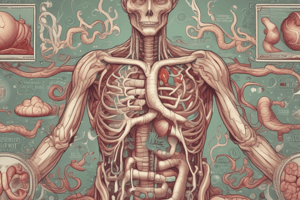Podcast
Questions and Answers
किस भाग में आंवल और पित्ताशय द्वारा छोड़ा गया पित्त वसा की पचाई को सुनिश्चित करने में मदद करता है?
किस भाग में आंवल और पित्ताशय द्वारा छोड़ा गया पित्त वसा की पचाई को सुनिश्चित करने में मदद करता है?
- पेट में
- छोटे आंत में (correct)
- आंत में
- मोटे आंत में
कौन-कौन से अंग खाद्य पदार्थों को सरल चीजों में टुकड़े करने में मदद करते हैं?
कौन-कौन से अंग खाद्य पदार्थों को सरल चीजों में टुकड़े करने में मदद करते हैं?
- पेट की सरपिलि
- पेट की जन्तुकों
- पेट की प्रोजेक्शन
- लीवर की धारा (correct)
बैक्टीरिया किस काम में महत्वपूर्ण भूमिका निभाते हैं?
बैक्टीरिया किस काम में महत्वपूर्ण भूमिका निभाते हैं?
- मोटे आंत में
- कोलन में (correct)
- लीवर में
- पेट में
किस संरचना से पोषक पदार्थों को सोने की सतह मोहलती है?
किस संरचना से पोषक पदार्थों को सोने की सतह मोहलती है?
'हेपेटिक पोर्टल वेन' कि माध्यम से, पोषक प्रसारित होकर कहाँ जाते हैं?
'हेपेटिक पोर्टल वेन' कि माध्यम से, पोषक प्रसारित होकर कहाँ जाते हैं?
पहले 'सुपोतिभ' के 'पोषक' 'सतह' में 'प्रसारक' 'प्रस्' 'ति' को 'हाइ' 'कौन' 'स� �्' 'प्र� �्' '� �्'
पहले 'सुपोतिभ' के 'पोषक' 'सतह' में 'प्रसारक' 'प्रस्' 'ति' को 'हाइ' 'कौन' 'स� �्' 'प्र� �्' '� �्'
मुँह में खाना डालने से किस प्रक्रिया की शुरुआत होती है?
मुँह में खाना डालने से किस प्रक्रिया की शुरुआत होती है?
पेट में पहुंचने के बाद, क्या मद्दों का संक्रमण होता है?
पेट में पहुंचने के बाद, क्या मद्दों का संक्रमण होता है?
मुँह में सुन्नता कौन-कौनसी एंजाइम मिलती है?
मुँह में सुन्नता कौन-कौनसी एंजाइम मिलती है?
Flashcards
Role of saliva in digestion
Role of saliva in digestion
Saliva contains enzymes like amylase that begin breaking down carbohydrates.
Stomach acid's function
Stomach acid's function
Stomach acid helps break down proteins and create a harsh environment for bacteria.
Small intestine structure
Small intestine structure
The small intestine's lining has villi and microvilli for maximum surface area for nutrient absorption.
Bile's role
Bile's role
Signup and view all the flashcards
Pancreatic juice function
Pancreatic juice function
Signup and view all the flashcards
Large intestine purpose
Large intestine purpose
Signup and view all the flashcards
Waste elimination process
Waste elimination process
Signup and view all the flashcards
Nutrient absorption
Nutrient absorption
Signup and view all the flashcards
Cellular processes fueling
Cellular processes fueling
Signup and view all the flashcards
Study Notes
Manav Me Pachan: Unraveling Human Digestion
Human digestion is a complex yet marvelous process essential for turning what we eat into nutrients our bodies can utilize. As you delve into this journey through your own body, let's explore how food transforms from its solid form to microscopic molecules available for absorption—a process known as manav me pachan in Hindi.
First Stop: Mouth
The odyssey begins with placing a bite of food into your mouth, where chewing breaks down large pieces into smaller ones and mixes them with saliva containing enzymes like amylase to start breaking down carbohydrates. Salivary glands produce several liters of saliva each day, helping us swallow comfortably and begin preliminary breakdown before the meal enters the esophagus.
Next Station: Stomach
After passing through the esophagus into the stomach, food encounters stomach acid and stomach juices, which help further break it down. Despite popular belief, the stomach does not cook or sterilize food; rather, it churns and grinds the bolus while secreting hydrochloric acid and pepsin, compounds crucial for protein digestion. In addition, nerves in the stomach lining secrete gastrin, an essential hormone responsible for stimulating the secretion of gastric acids.
Third Destination: Small Intestine
Following the stomach, the partially digested product moves into the small intestine, here referred to as 'jejunum.' This narrow tube stretches over two-thirds of the length of the entire gut and contains numerous fingerlike projections called villi and even tinier structures called microvilli, providing a massive surface area for nutrient absorption.
In the small intestine, bile released by the liver and gallbladder facilitates fat digestion, and pancreatic juice containing important enzymes such as trypsin and lipases helps digest proteins and fats, respectively. Here too, additional enzyme production occurs via duodenal cells lining the walls. These enzymes break down starch into simple sugars, contributing to overall digestion efficiency.
Fourth Port: Large Intestine
Soon after completing their mission of absorbing nutrients in the small intestine, unabsorbed materials enter the large intestine, also known as the colon. Water reabsorption and waste management occur primarily within the colon, converting undigested matter into feces ready for excretion. Bacteria play a vital role in fermenting undigested fibrous material, producing useful short-chain fatty acids that support the immune system and maintain intestinal health.
Final Stage: Absorption and Elimination
Once nutrients have been broken down into simpler components and absorbed into blood vessels lining the inner surfaces of these organs, they travel to the liver via the hepatic portal vein. Next, they circulate throughout the body to fuel various cellular processes and functions. Lastly, remaining indigestible particles exit the body through defecation, which normally happens daily, although frequency may vary among individuals based on dietary habits and other factors.
Throughout this complex, multiphased procedure, communication between specialized cells, tissues, and organs ensures proper timing and function, enabling our bodies to efficiently convert ingested foods into energy and building blocks for healthy living. Understanding manav me pachan provides valuable insights into maintaining our physical wellbeing and encouraging conscious consumption choices.
Studying That Suits You
Use AI to generate personalized quizzes and flashcards to suit your learning preferences.




